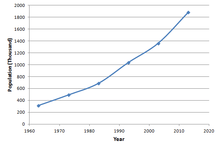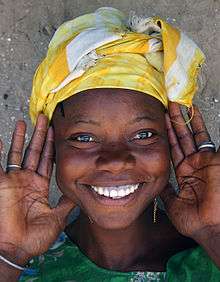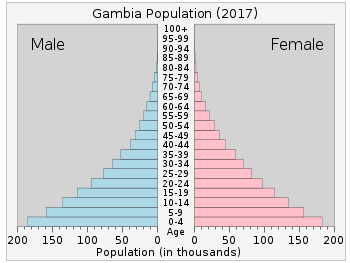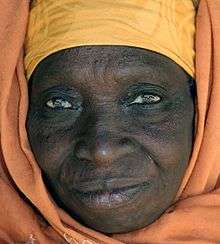Demographics of the Gambia
The demographic characteristics of the population of The Gambia are known through national censuses, conducted in ten-year intervals and analyzed by The Gambian Bureau of Statistics (GBOS) since 1963. The latest census was conducted in 2013. The population of The Gambia at the 2013 census was 1.8 million. The population density is 176.1 per square kilometer, and the overall life expectancy in The Gambia is 64.1 years. Since the first census of 1963, the population of The Gambia has increased every ten years by an average of 43.2 percent. Since 1950s, the birth rate has constantly exceeded the death rate; the natural growth rate is positive. The Gambia is in the second stage of demographic transition. In terms of age structure, The Gambia is dominated by 15- to 64-year-old segment (57.6%). The median age of the population is 19.9 years, and the gender ratio of the total population is 0.98 males per female.
| Demographics of The Gambia | |
|---|---|
 Scatter plot of the population of The Gambia (in thousands) from 1963–2013 | |
| Population | 2,157,846 (2018) |
| Density | 176.1/sq km (2013) |
| Growth rate | 38.3% |
| Birth rate | 29.4 births/1,000 population (2017 est.) |
| Death rate | 7 deaths/1,000 population (2017 est.) |
| Life expectancy | 65.1 (2017 est.) |
| • male | 62.8 (2017 est.) |
| • female | 67.5 (2017 est.) |
| Fertility rate | 3.52 children born/woman (2017 est.) |
| Infant mortality rate | 60.2 deaths/1,000 live births (2017 est.) |
| Age structure | |
| 0–14 years | 37.44% (2017 est.) |
| 15–64 years | 59.08% (2017 est.) |
| 65 and over | 3.48% (2017 est.) |
| Sex ratio | |
| Total | 0.98 (2013) |
| At birth | 1.03 (2013 est.) |
| Under 15 | 1.01 (2013 est.) |
| 15–64 years | 0.96 (2013 est.) |
| 65 and over | 0.90 (2013 est.) |
| Nationality | |
| Nationality | Noun: Gambian |
| Major ethnic | African (99%) (2003) |
| Minor ethnic | Non-African (1%) (2003) |
| Language | |
| Official | English |
| Spoken | Mandinka, Wolof, Fula |
Population
| Year | Pop. | ±% |
|---|---|---|
| 1963 | 315,486 | — |
| 1973 | 493,499 | +56.4% |
| 1983 | 687,817 | +39.4% |
| 1993 | 1,038,145 | +50.9% |
| 2003 | 1,360,681 | +31.1% |
| 2013 | 1,882,450 | +38.3% |
| Source: The Gambia Bureau of Statistics[1] | ||
With a population of 1.88 million in 2013, The Gambia ranks 149th in the world by population.[1] Its population density is 176.1 inhabitants per square kilometer (456.1 inhabitants per square mile).[2] The overall life expectancy in The Gambia is 64.1 years.[3] The total fertility rate of 3.98 is one of the highest in the world.[4] Since 1950, the United Nations (UN) estimated the birth rate exceeds the death rate.[5] The Gambia Bureau of Statistics (GBOS) estimates the population of The Gambia is expected to reach 3.6 million in 20 years.[1] The population of The Gambia has increased each census, starting with 315 thousand in 1963 to 1.8 million in 2013.[1] The GBOS predicted the reason for the increase from 2003 to 2013 was more coverage in the latter census compared to the former's.[6]
Vital statistics
Registration of vital events is in the Gambia not complete. The Population Department of the United Nations prepared the following estimates.[7]
| Period | Live births per year | Deaths per year | Natural change per year | CBR* | CDR* | NC* | TFR* | IMR* |
|---|---|---|---|---|---|---|---|---|
| 1950-1955 | 13,000 | 9,000 | 4,000 | 43.7 | 31.3 | 12.4 | 5.29 | 221 |
| 1955-1960 | 16,000 | 10,000 | 6,000 | 48.3 | 30.6 | 17.8 | 5.46 | 210 |
| 1960-1965 | 20,000 | 12,000 | 8,000 | 50.2 | 29.7 | 20.5 | 5.70 | 199 |
| 1965-1970 | 22,000 | 12,000 | 10,000 | 50.8 | 28.2 | 22.6 | 5.96 | 185 |
| 1970-1975 | 26,000 | 12,000 | 14,000 | 52.0 | 23.9 | 28.1 | 6.20 | 164 |
| 1975-1980 | 31,000 | 12,000 | 19,000 | 52.6 | 20.1 | 32.6 | 6.34 | 140 |
| 1980-1985 | 35,000 | 11,000 | 24,000 | 50.5 | 16.4 | 34.1 | 6.29 | 117 |
| 1985-1990 | 42,000 | 12,000 | 30,000 | 48.1 | 13.7 | 34.4 | 6.14 | 101 |
| 1990-1995 | 49,000 | 14,000 | 35,000 | 46.5 | 13.1 | 33.4 | 6.03 | 93 |
| 1995-2000 | 54,000 | 15,000 | 39,000 | 44.7 | 12.2 | 32.6 | 5.80 | 86 |
| 2000-2005 | 59,000 | 15,000 | 44,000 | 42.4 | 10.9 | 31.5 | 5.46 | 80 |
| 2005-2010 | 64,000 | 16,000 | 48,000 | 39.3 | 9.8 | 29.5 | 5.10 | 74 |
| * CBR = crude birth rate (per 1000); CDR = crude death rate (per 1000); NC = natural change (per 1000); IMR = infant mortality rate per 1000 births; TFR = total fertility rate (number of children per woman) | ||||||||
Fertility Rate (The Demographic Health Survey and Multiple Indicator Cluster Surveys) [8][9]
Fertility Rate TFR (Wanted Fertility Rate) and CBR (Crude Birth Rate):
| Year | CBR (Total) | TFR (Total) | CBR (Urban) | TFR (Urban) | CBR (Rural) | TFR (Rural) |
|---|---|---|---|---|---|---|
| 2013 | 40.5 | 5.6 (4.7) | 37.7 | 4.7 (4.1) | 43.4 | 6.8 (5.6) |
| 2019-20 | 34.4 | 4.4 | 32.5 | 3.9 | 38.9 | 5.9 |
Structure of the population (DHS 2013) (males 23,904, females 25,649, total 49,553) :
| Age Group | Male (%) | Female (%) | Total (%) |
|---|---|---|---|
| 0–4 | 18.5 | 16.4 | 17.4 |
| 5–9 | 16.6 | 15.3 | 15.9 |
| 10–14 | 12.8 | 12.5 | 12.6 |
| 15–19 | 10.3 | 10.4 | 10.3 |
| 20–24 | 8.5 | 9.1 | 8.8 |
| 25–29 | 6.8 | 8.0 | 7.4 |
| 30–34 | 5.5 | 6.5 | 6.0 |
| 35–39 | 4.5 | 4.7 | 4.6 |
| 40–44 | 3.8 | 3.3 | 3.5 |
| 45–49 | 2.9 | 2.4 | 2.6 |
| 50–54 | 2.1 | 4.1 | 3.1 |
| 55–59 | 1.5 | 1.9 | 1.7 |
| 60–64 | 2.3 | 1.9 | 2.1 |
| 65–69 | 1.5 | 1.2 | 1.3 |
| 70–74 | 1.0 | 0.9 | 1.0 |
| 75–79 | 0.7 | 0.5 | 0.6 |
| 80+ | 0.8 | 1.0 | 0.9 |
| Age group | Male (%) | Female (%) | Total (%) |
|---|---|---|---|
| 0–14 | 47.9 | 44.2 | 45.9 |
| 15–64 | 48.1 | 52.2 | 50.3 |
| 65+ | 4.0 | 3.6 | 3.8 |
Fertility data as of 2013 (DHS Program):[10]
| Local Government Area | Total fertility rate | Percentage of women age 15–49 currently pregnant | Mean number of children ever born to women age 40–49 |
|---|---|---|---|
| Banjul | 3.9 | 5.8 | 4.3 |
| Kanifing | 4.0 | 5.9 | 5.1 |
| Brikama | 5.6 | 7.7 | 5.9 |
| Mansakonko | 6.0 | 9.1 | 7.0 |
| Kerewan | 6.3 | 8.8 | 6.9 |
| Kuntaur | 7.2 | 11.5 | 6.6 |
| Janjanbureh | 6.8 | 9.2 | 6.5 |
| Basse | 7.0 | 10.9 | 6.2 |

Life expectancy
| Period | Life expectancy in Years[11] |
|---|---|
| 1950–1955 | 30.24 |
| 1955–1960 | |
| 1960–1965 | |
| 1965–1970 | |
| 1970–1975 | |
| 1975–1980 | |
| 1980–1985 | |
| 1985–1990 | |
| 1990–1995 | |
| 1995–2000 | |
| 2000–2005 | |
| 2005–2010 | |
| 2010–2015 |
Other demographic statistics
Demographic statistics according to the World Population Review in 2019.[12]
- One birth every 6 minutes
- One death every 31 minutes
- One net migrant every 206 minutes
- Net gain of one person every 8 minutes
The following demographic statistics are from the CIA World Factbook.[13]
Population
- 2,092,731 (July 2018 est.)
Age structure

- 0-14 years: 36.97% (male 388,615 /female 385,172)
- 15-24 years: 20.31% (male 210,217 /female 214,807)
- 25-54 years: 34.9% (male 357,934 /female 372,428)
- 55-64 years: 4.26% (male 42,655 /female 46,591)
- 65 years and over: 3.55% (male 34,328 /female 39,984) (2018 est.)
 Elderly Gambian woman, January 2008, The Gambia.
Elderly Gambian woman, January 2008, The Gambia.
Birth rate
- 28.6 births/1,000 population (2018 est.) Country comparison to the world: 43rd
Death rate
- 6.9 deaths/1,000 population (2018 est.) Country comparison to the world: 132nd
Total fertility rate
- 3.42 children born/woman (2018 est.) Country comparison to the world: 44th
Median age
- total: 21.3 years. Country comparison to the world: 184th
- male: 20.9 years
- female: 21.6 years (2018 est.)
Population growth rate
- 1.99% (2018 est.) Country comparison to the world: 48th
Mother's mean age at first birth
- 20.9 years (2013 est.)
- note: median age at first birth among women 25-29
Contraceptive prevalence rate
- 9% (2013)
Net migration rate
- -1.9 migrant(s)/1,000 population (2017 est.) Country comparison to the world: 158th
Dependency ratios
- total dependency ratio: 92.3 (2015 est.)
- youth dependency ratio: 87.8 (2015 est.)
- elderly dependency ratio: 4.5 (2015 est.)
- potential support ratio: 22.3 (2015 est.)
Urbanization
- urban population: 61.3% of total population (2018)
- rate of urbanization: 4.07% annual rate of change (2015-20 est.)
Life expectancy at birth
- total population: 65.4 years (2018 est.)
- male: 63 years (2018 est.)
- female: 67.8 years (2018 est.)
Religions
- Muslim 95.7%, Christian 4.2%, none 0.1%, no response 0.1% (2013 est.)
Literacy
definition: age 15 and over can read and write (2015 est.)
- total population: 55.5% (2015 est.)
- male: 63.9% (2015 est.)
- female: 47.6% (2015 est.)
School life expectancy (primary to tertiary education)
- total: 9 years (2010)
- male: 9 years (2010)
- female: 9 years (2010)
Unemployment, youth ages 15-24
- total: 13.1% (2012 est.)
- male: 9.1% (2012 est.)
- female: 17.2% (2012 est.)
References
- The Gambia Bureau of Statistics 2013, p. 6
- The Gambia Bureau of Statistics 2013, p. 10
- "Africa :: Gambia, The". The World Factbook. Central Intelligence Agency. Retrieved 23 February 2014.
- "Country Comparison :: Total Fertility Rate". The World Factbook. Central Intelligence Agency. Retrieved 23 February 2014.
- "World Population Prospects: The 2012 Revision". United Nations. Archived from the original on May 6, 2011. Retrieved February 24, 2014.
- The Gambia Bureau of Statistics 2013, pp. 6–7
- Population Division of the Department of Economic and Social Affairs of the United Nations Secretariat, World Population Prospects: The 2010 Revision Archived May 6, 2011, at the Wayback Machine
- "The DHS Program - Quality information to plan, monitor and improve population, health, and nutrition programs". www.dhsprogram.com.
- "The Gambia MICS 2018" (PDF).
- "The Gambia Demographic and Health Survey 2013" (PDF). The Gambia Demographic and Health Survey. 2013.
- "World Population Prospects - Population Division - United Nations". esa.un.org. Archived from the original on 2016-09-19. Retrieved 2018-08-26.
- "Gambia Population 2019", World Population Review
- "The World FactBook - Gambia, The", The World Factbook, July 12, 2018

References
| Wikimedia Commons has media related to Demographics of Gambia. |
- The Gambia Bureau of Statistics (2013). "The Gambia 2013 Population and Housing Census Preliminary Results" (PDF). The Gambia Bureau of Statistics. Retrieved February 24, 2014.CS1 maint: ref=harv (link)